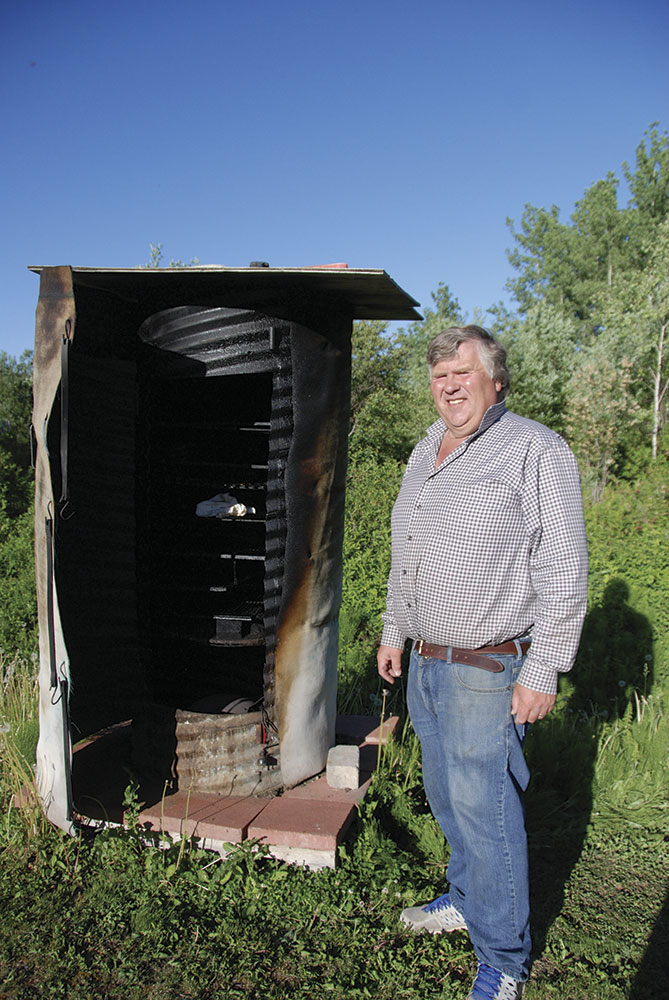
Photo Credit: Pat Moss
Smokin’ Good Fish: Many ways to smoke a salmon
A slight breeze rustles the aspen leaves, and on it drifts the distinct scent of a northern summer. It could be a campfire or a Bar-B-Q, but when the days are long and when the salmon are running, the smell of smoke carries with it the flavour of curing fish and the promise of good eating throughout the winter.
Smoking salmon is a tradition many northerners can relate to and every person adds their own individual touch. Home-fashioned drying racks, fillet knives, cutting boards, coolers and ‘secret recipes’ are lined up like lucky charms at a bingo night. Everyone has their own ‘right’ way of doing things. However, whether you are in your town backyard using an electric smoker, at a family smokehouse on reserve, or out on the land using a tarp and pine poles, the method isn’t as important as the end result.
Rita George, or Gallaghun, is from House Keyikh Winits of the Gidimt’en Clan, Wet’suwet’en Nation. She laughs as she recalls her first attempt, many years ago, at smoking fish by herself. “I didn’t realize that the fish had to be dried first for a few days. My father-in-law looked in the smokehouse and the fish all looked like footballs! My mother-in-law helped me out; she explained that the fish has to be cleaned very, very thoroughly. Cut it in half and keep a tiny smoke under it—it is left for a few days until the skin is really firm. This is called tlhkanil’dez. That is the first step.”
George explains that the next step is to butterfly the fish so the inside flesh is exposed to the small amount of smoke and allowed to dry for another one or two days. “When the fish is firm on the outside and on the inside, we start cutting the strips. The easiest way is to make an A-Frame and put a salmon on it and split it in half and it just sits on there. You then cut the flesh off really thin and make strips out of it.” The A-frame cutting board is called a bik’its lhk’ec’init’as. It looks like a sandwich-board sign and keeps the fish in a position that allows very thin strips to be cut off the fish without wasting anything.”
Don’t overcook
“If the strips are too thick, they can spoil from the inside,” warns George. The strips are hung in the smokehouse for further drying. “You put the pieces in the smokehouse for a couple of days and then you have hayu’tseh—half-dried fish.” George demonstrates how to prepare hayu’tseh by putting a piece in a pot of boiling water until it is no longer frozen. “OK, you don’t want to overcook it,” she says as she drains it through a strainer in the sink. “We would eat hayu’tseh with wild rice(root). All the elders used to go to Hungry Hill to dig wildrice.”
She continues to explain the next steps. “If you keep the strips in the smokehouse for a few more days, you make b’eh. This is the food that the trappers would take out on the territory.” B’eh is very dry and has the texture of jerky. “Some people like to put brown sugar on the fish, but I don’t like that. I just like a little salt and pepper.”
George describes how much work it takes to smoke fish the traditional way. “When I have my smokehouse going at Broman Lake, I get up every day at four in the morning to make sure the fire is going. This way you don’t get flies or insects on the fish. I like to use poplar wood—every Nation uses a different wood and it makes the fish taste slightly different. You don’t want to use a very pitchy wood, because it imparts that flavour into the fish and doesn’t taste very good. You also have to keep everything very clean.” Now a respected elder and expert fish smoker, George has passed the tradition to her children, who help her with the process.
Smithers resident George Schultze is known among his friends as making some of the best smoked salmon around. “My philosophy is to keep it simple,” he says. “I’ve been using the same recipe since 1978—it was one of the better recipes I found and I’ve been using it ever since.”
“For good-quality smoked fish, start with high-quality fish. Some people see an old, spawned-out fish and they say ‘Oh, that’s a good smoker.’” Schultze wrinkles his nose at the idea. “You can tell if the fish is old, even when you smoke it.”
He continues, “I debone them completely and remove all the pinbones by cutting them out with a knife. The brine has to penetrate into the meat, so I make cuts in the fish so there’s no more than half an inch of flesh from a cut. Then I rinse off all the pieces so there’s no slime.” Schultze uses a dry brine: one part salt and four parts brown sugar mixed thoroughly in a bowl.
Hands-off approach
“I layer the fish in the bottom of a container that isn’t going to corrode. Now you make sure there’s brine mixture into every cut. Don’t be chintzy—before I put the next layer on I cover up the fish with the brine mixture so you pretty much can’t see the fish. Everything’s always skin down.” He describes repeating the process, layer upon layer until all the fish is used up. Keeping things cool is also very important. “You can put it in a big cooler with some ice packs for about 9-10 hours—after a certain point, the meat is saturated, so it doesn’t make a difference if you add more time.”
Schultze likes the hands-off approach to getting the fish ready. “I put it in the brine in the morning for eight or nine hours and in the evening I open it up. It is floating in a soupy liquid. I then take each piece and rinse it off and take off any slime. I put it meat-side down in a clean sink so it can drain a bit. Then I put it in the smoker.”
Schultze’s smoker is a large piece of corrugated culvert wrapped in indoor-outdoor carpet. Several racks are stacked inside and a simple electric hotplate sits at the bottom. He gets the smoker going by cutting red alder into small slabs and stacking them on top of the hotplate. “I put the fish in, put on the wood and close the door. It isn’t very high-tech.” He smiles and pulls the rubber bungee cords to latch the door shut. “It takes about an hour to get going and once it starts smoking profusely, I unplug the element and go to bed. In the morning the fish is ready. By then, it has cooled a bit and the fish has stiffened up which makes it much easier to handle.”
Both Schultze and George package their fish the modern way in vacuum seal bags, plastic bags or Saran wrap and put it in the deep-freeze. Although their approaches are different, they are both tried and tested with many years of successfully creating food that their friends and family are happy to share.





